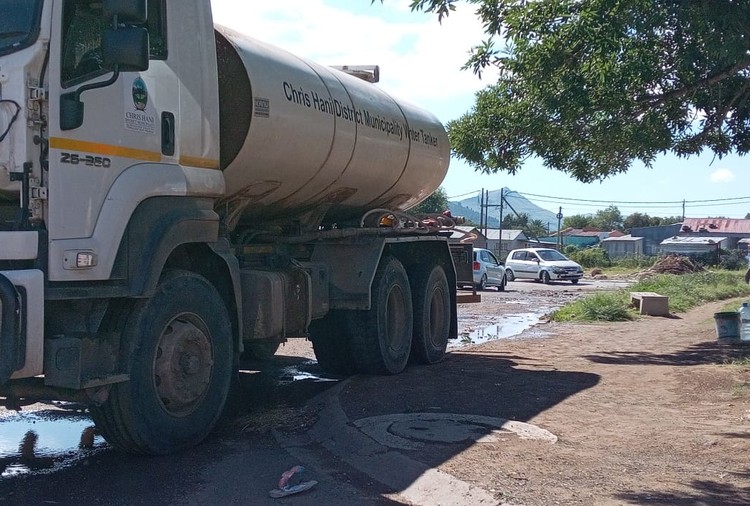
25 April 2025
Water trucks are supplying water to high-lying areas of Komani where taps ran dry in November last year, but residents say they do not arrive often enough. Photo: Nombulelo Damba-Hendrik.
For more than six months Komani, formerly Queenstown, has suffered water outages. Taps having been completely dry in high-lying areas since November.
The high-lying areas, such as Nkululekweni, are being serviced by water trucks, but residents say they are insufficient as they only come to the area twice a week, and sometimes less.
Last year the Bonkolo Dam, which is one of the town’s water supplies, dried up to the point water could no longer be abstracted. The other supply, the Waterdown Dam, suffered leaks in the pipelines.
Chris Hani District Municipality spokesperson Thobeka Mqamelo said most of the Waterdown leaks have been fixed, and the Bonkolo Dam level has risen to 22%. Supply to the city centre and middle-class suburbs has been restored.
But residents in poorer high-lying areas are still without water. Meanwhile, 23km away, the Xonxa Dam is 100% full, but the Xonxa bulk water scheme initiated in 2012 has not been completed. The initial completion deadline was 2018.
The Chris Hani District Municipality budgeted R546-million for the bulk water scheme, but close to R700 million has been spent on the project so far, said Mqamelo.
In January the situation was so dire that charity organisation Gift of the Givers tried to help by delivering four water trucks, rehabilitating two boreholes at Komani Hospital, and drilling new boreholes at Sixishe Primary school, Edlelweni Primary school, Luvuyo Lerumo Senior Secondary, and Inkwanca Senior Secondary school.
But the borehole pumps have not yet been connected to an electricity supply. Mqamelo said it was not clear whether the boreholes were just for the school, or whether they should benefit the broader community, so it was not clear who should be responsible for the electrical connections. “Engagements are in progress,” she said.
Gift of the Givers also installed water tanks in the areas of Mlungisi, Ezibeleni, VANS, and Top Town.
Resident Nolulama Moses from Zone 2 in Nkululekweni said she has forgotten that she has a tap in her house, as no water has come out of them for five months.
Moses said she was too old to fetch water. She is completely reliant on the water trucks, but she never knows when they will arrive.
“Every day I always sit outside the house so that when it comes, I can see it.”
She said the worst part was not being able to use her toilet.
“We are now using buckets to relieve ourselves and throw it away in a canal. I’m sure that will affect our health,” said Moses.
Resident Nosaphiwe Booi said they have been begging the municipality to restore water in their area. She said the city centre and middle-class suburbs had water, but everyone else had to suffer.
“There’s an area under us called Izinyoka. There they get water, even if it’s for an hour a day but they do get it. In our area it’s been five months now with no water.” She said the water trucks were unreliable, and when they didn’t arrive, residents walked to the stadium to fetch water, which was “very far”.
Booi said people who weren’t able to get to the stadium paid R10 for someone to fill a 20-litre bucket.
“In some houses it’s a granny with small children: 20 litres would not be enough, meaning everyday that granny must pay money to buy water. This is very frustrating and the municipal officials do not care about us because they have water,” she said.
Community leader Sibulele Mninzi said some people walked for an hour to fetch water from the stadium, and it was only open during the day so people who were at work had to hire people to fetch water for them.
Mqamelo said the district municipality mayor Lusanda Sizani visited the Xonxa Dam project recently and was satisfied with the progress.
“The (district municipality) technical team is closely monitoring the system to determine the functionality of all components after a lengthy period of inactivity,” said Mqamelo.
She said the municipality continues carting water to high lying areas, and water rationing was in effect in other areas until the water supply systems were at full operation.